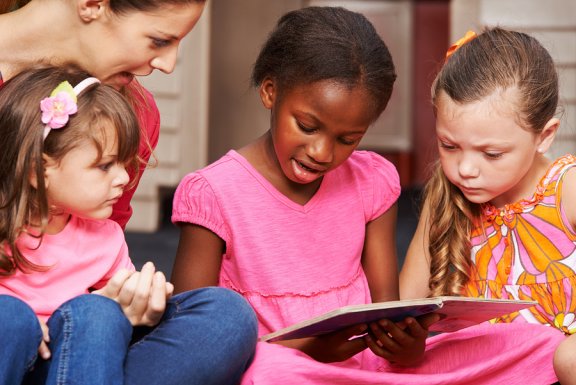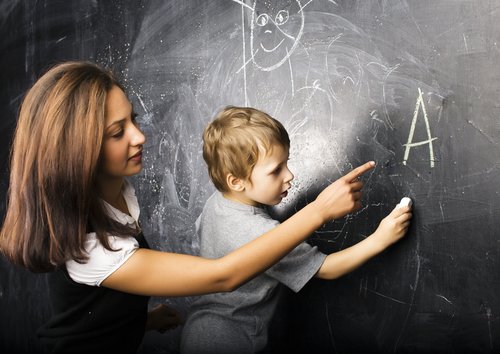What Are The Different Methods for Teaching Literacy?

In education, children generally learn how to read and write between 4 and 7 years of age. However, it’s important to know that there are various methods for teaching literacy. Today, we’ll go over the main ones.
Learning to read and write is a fundamental learning period. That’s because knowing how to read and write gives children the tools to understand other areas.
There are many theories about the best methods for teaching literacy. Below, we’ll discuss the most popular methods.
The different methods for teaching literacy
The alphabetic method
Educators have used this method of teaching literacy since ancient times. This method involves following the alphabet. In other words, children study each letter of the alphabet in order, learning its name and pronunciation(s). Simultaneously, they learn to write each one.
With each letter that children learn, they also learn simple combinations between consonants and vowels. In doing so, they form syllables – for example, l + a = la. They start two letter syllables and then come to create longer syllables and then words.
Once children learn to form words, they learn how to create entire sentences. In the alphabetic method of teaching literacy, reading starts off as mechanical.
Once children have incorporated the skill, they move onto expressive reading, with punctuation marks. Then, finally, they move on to comprehensive reading.
The syllabic method
This procedure for teaching literacy starts with the learning of vowels – a, e, i, o, u and y. Then, children move on to learn consonants, starting with the ones that are easiest to pronounce.

Then, students move on to form syllables. They use each consonant with each of the vowels. For example: ma, me, mi, mo, mu, my. Finally, they come to form more complex syllables, words and phrases.
The phonetic method
This method of teaching literacy uses mainly phonetic material. Here, educators first teach the vowels by their sounds, using figures and images with objects that start with each of these letters. Parallel to reading, they teach the writing of each vowel.
Then, teachers explain each consonant with its sound, using images of objects or animals that start with each one. Children learn to combine each consonant with the five vowels, forming simple syllables like pa, pe, pi, po, pu.
Then, teachers use the syllables that the children are now familiar with in order to form simple words and phrases that include only those words. Finally, teachers teach inverse, mixed and complex syllables, diphthongs and triphthongs. Once these syllables have been integrated into learning, they are then used to form words and phrases.
“Reading and writing make up part of the same process, and the teaching of both is simultaneous. That’s why there is one single term to describe the process of learning both skills.”
The global method
There exists another less traditional method for teaching literacy that is based on global learning. Its creators warn, however, that this global or analytic method is only effective within a framework that is entirely concrete and intuitive.
The method involves approaching literacy in the same way that children learn to speak. From the start, educators present different units with an integral meaning.
Through visual memory, children learn to recognize phrases and, within those phrases, words. They come to make associations and identify elements that are the same in different words and, in this way, learn to recognize letters.
In this approach, the written word is a simple graphic representation of an image that children have in their minds.

The duration of the process of teaching literacy with this method can vary greatly. It will depend on the level of maturity of each child, his or her intelligence type and ability to place him or herself in space and time, as well as other factors.
At the same time, this method of teaching reading and writing involves four very distinct stages. These stages are: comprehension, elaboration and, finally, production .
In this last stage, children are perfectly able to understand what they read, explain it, and answer questions about content. They can also write short letters, descriptions and compositions.
Children who learn to read and write with the global method become fast and fluent readers. This is likely due to their rapid comprehension of what they’re reading and writing.
In conclusion, these different methods for teaching literacy help boost our children’s learning in the classroom. However, they’re also very effective at home.
Therefore, set some time aside to help your little one develop his or her maximum linguistic abilities.
All cited sources were thoroughly reviewed by our team to ensure their quality, reliability, currency, and validity. The bibliography of this article was considered reliable and of academic or scientific accuracy.
- CASTILLO, N. D. P. C., LENGUA, D., & COEDUCACIÓN, N. (2010). Principales métodos de aprendizaje de la lectoescritura. Revista de innovación y experiencias educativas, 1-8. https://www.ubilapaz.edu.bo/wp-content/uploads/2020/03/CLASE1_PSI_7_PSICOLOGIA-EDUCATIVAII_M_z_SANJINES_CHRIS_1.pdf
- Calzadilla Pérez, O. O. (2012). Métodos de enseñanza de la lectoescritura en la Educación Primaria. Academia Española.
- Aramburu, R. (2012). Análisis de los métodos de lectoescritura en español desde la perspectiva de la conciencia fonológica(Bachelor’s thesis). https://reunir.unir.net/handle/123456789/473